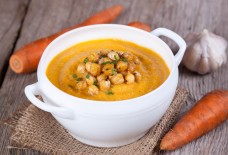Let's Dine with Scheherazade!
By: Habeeb Salloum/Arab America Contributing Writer
My daughters Leila and Muna along with myself co-authored a unique cookbook entitled Scheherazade’s Feasts: Foods of the Medieval Arab World published in 2013 by the University of Pennsylvania Press. It deals with medieval Arab cookery. The book is based on six medieval culinary Arabic manuscripts dating from the 10th to the 13th centuries. We chose about 100 recipes, translated them then redacted them, made them and then enjoyed the dishes. It was a lot of fun dining on the foods of the medieval Arabs.
This is not only a cookbook that brings Arab medieval recipes back to life but also a study of how the cuisine developed and how it affected the Arab gastronomy and the gastronomic cultures beyond. Our work is easy to read, at times humourous, historically researched and above all the dishes despite being from medieval Arab period are redacted to our modern times yet retain their original flavor.
From the 7th to the 13th centuries, the Islamic world stretched from China to the middle of France. The throbbing heart of this vast area was the Arab world. From it emerged a Golden Age of the culinary arts and this inspired a gourmet cuisine accompanied by a widespread body of literature, some of which has come down to our times.
Some of the dishes travelled from the Middle East to North Africa then to Andalusia and from there spread through Europe and later to the New World.
In Scheherazade’s Feasts we present more than a hundred of these recipes that were once enjoyed by a sophisticated and cosmopolitan medieval Arab society.
This is a sample of a recipe from medieval Arab Andalusia that we have redacted in order that it be relished today as it was in the days of Scheherazade.
al-Summaqiya – Made of Sumac
Serves 4–6
Redacted from the medieval culinary text of al-Tujibi, Fadala al-Khiwan fi Tayyibat al-Ta’am wa al-Alwan
Sumac, derived from the Arabic summaq, maybe the last of the great condiments still to be widely taken up in the West. Middle Eastern cooks have employed it for thousands of years in numerous dishes as a replacement for lemon juice or vinegar. This sour seasoning is as indispensable to modern Middle Eastern cuisine as it was to the kitchens of the Sumerians, ancient Egyptians, and medieval Arabs. Its berries are gathered a little before maturity, dried in the sun, and crushed to remove the seed. The dried fruit pulp is then pulverized to make the brick-red sumac seasoning.
3 pounds of chicken, cleaned, skinned, and jointed, or 3 pounds. skinless, boneless chicken breast, cut into medium-sized pieces
1 1/2 teaspoons salt
2 tablespoons olive oil
1 1/2 teaspoons black pepper
1 1/2 teaspoons ground coriander seeds
1 medium onion, finely chopped
4 tablespoons sumac
Place the chicken, salt, olive oil, black pepper, ground coriander, and onion in a saucepan and cover with water. Bring to a boil and remove any scum. Cover and cook over medium heat for 30 minutes.
In the meantime, place the sumac in a clean piece of cloth. Tie up the cloth to form a little and place it in the saucepan. Cook over medium-low heat for a further 30 minutes or until the chicken is well cooked, stirring occasionally and adding a little more water if necessary. Remove the sumac bag from the saucepan, transfer the saucepan contents to a serving bowl, and serve over plain rice.
Taken from Scheherazade’s Feasts: Foods of the Medieval Arab World. Co-authors Habeeb Salloum, Muna Salloum and Leila Salloum Elias (Philadelphia: University of Pennsylvania Press, 2013)









